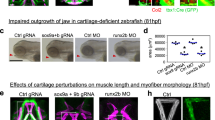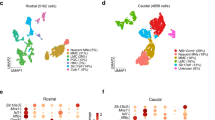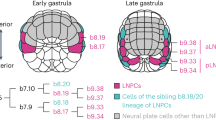Abstract
During embryonic development, muscles differentiate in the appropriate places and motoneurone growth cones find the appropriate muscles; both events occur concurrently and with remarkable specificity. What are the cellular interactions that orchestrate this coordinated development of nerve and muscle? In the development of vertebrate skeletal muscles, motoneurone growth cones arrive in the periphery along stereotyped routes and enter the appropriately located masses of mesodermal cells usually before differentiated muscle fibres appear and before the masses cleave into separate muscles1–3. We find that a similar sequence of events occurs in the grasshopper embryo. We are interested in how mesodermal cells become organized into the appropriate muscles and what guides motoneurone growth cones to their appropriate targets. Fortunately, in the grasshopper embryo the mesodermal cells in the periphery and motoneurones in the central nervous system (CNS) are large, accessible and in many cases individually identifiable from early in their development. We report here the discovery of a class of large mesodermal cells, which we call muscle pioneers, that arise early in development when the embryonic environment is relatively simple and distances short. By their growth and association with particular sites along the ectoderm, the muscle pioneers appear to erect a scaffold for later developing muscles and motoneurone growth cones.
This is a preview of subscription content, access via your institution
Access options
Subscribe to this journal
Receive 51 print issues and online access
$199.00 per year
only $3.90 per issue
Buy this article
- Purchase on Springer Link
- Instant access to full article PDF
Prices may be subject to local taxes which are calculated during checkout
Similar content being viewed by others
References
Landmesser, L. J. Physiol., Lond. 284, 371 (1978).
Dennis, M. J. A. Rev. Neurosci. 4, 43 (1981).
Lance-Jones, C. & Landmesser, L. Proc. R. Soc. B214, 1 (1981).
Chang, S., Ho, R. K. & Goodman, C. S. Devl Biol. (submitted).
Taghert, P. T., Bastiani, M., Ho, R. K. & Goodman, C. S. Devl Biol. (in the press).
Ho, R. K. & Goodman, C. S. Nature 297, 404 (1982).
Andersen, D. T. in Developmental Systems : Insects Vol. 1 (eds Counce, S.J. & Waddington, C. H.) Academic, New York, (1972).
Bate, C. M. & Grunewald, E. B. J. Embryol. exp. Morph. 61, 317 (1981).
Goodman, C.S., Raper, J.A., Ho, R.K. & Chang, S. 40th Symp. Soc. dev. Biol., 275 (1982).
Author information
Authors and Affiliations
Rights and permissions
About this article
Cite this article
Ho, R., Ball, E. & Goodman, C. Muscle pioneers: large mesodermal cells that erect a scaffold for developing muscles and motoneurones in grasshopper embryos. Nature 301, 66–69 (1983). https://doi.org/10.1038/301066a0
Received:
Accepted:
Issue Date:
DOI: https://doi.org/10.1038/301066a0
This article is cited by
-
Muscle precursor cells in the developing limbs of two isopods (Crustacea, Peracarida): an immunohistochemical study using a novel monoclonal antibody against myosin heavy chain
Development Genes and Evolution (2008)
-
Differentiation of the body wall musculature in Macrostomum hystricinum marinum and Hoploplana inquilina (Plathelminthes), as models for muscle development in lower Spiralia
Roux's Archives of Developmental Biology (1996)
-
Segmental differentiation processes in embryonic muscle development of the grasshopper
Roux's Archives of Developmental Biology (1995)
-
Homonomies within the ventral muscle system and the associated motoneurons in the locust, Schistocerca gregaria (Insecta, Caelifera)
Zoomorphology (1995)
-
Drosophila glial development is regulated by genes involved in the control of neuronal cell fate
Roux's Archives of Developmental Biology (1994)
Comments
By submitting a comment you agree to abide by our Terms and Community Guidelines. If you find something abusive or that does not comply with our terms or guidelines please flag it as inappropriate.



